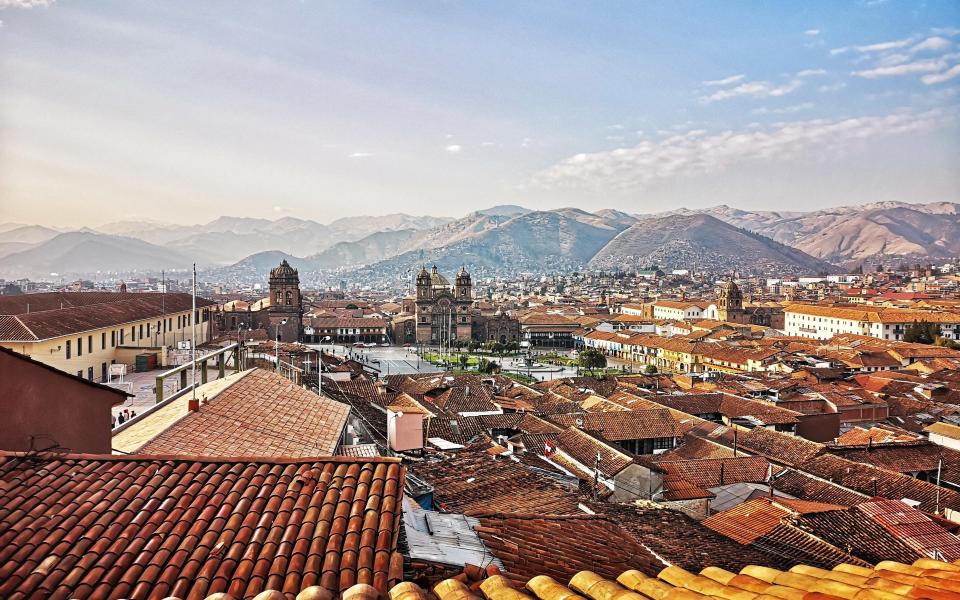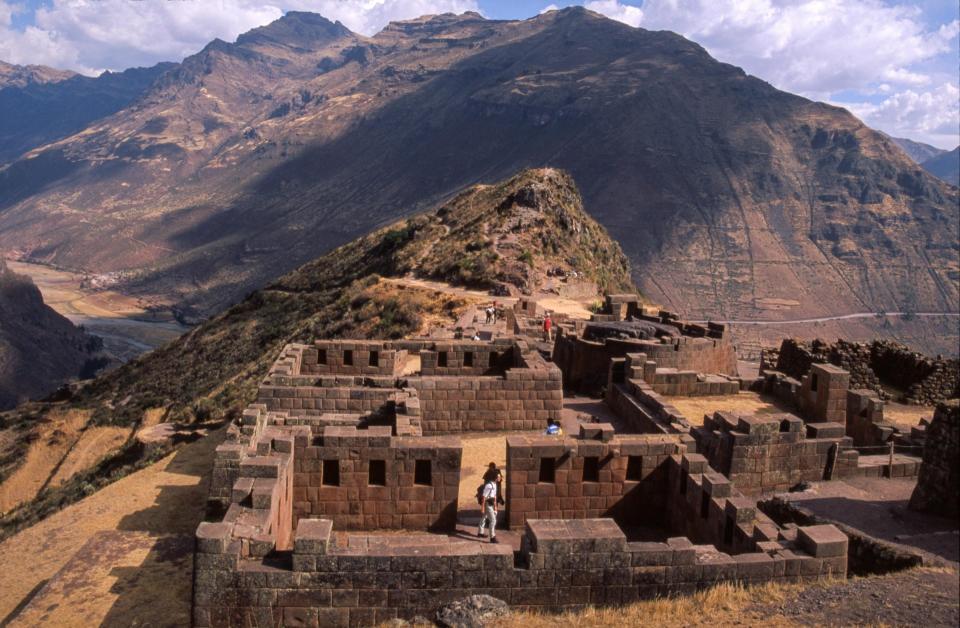Forget the Inca Trail – we trialled the new 'Black Diamond' route to Machu Picchu

The Inca king pointed the way, his gilded arm gesturing north-west from atop the fountain in Cusco’s Plaza des Armas; this was the bearing I’d follow from the navel of the world to the terraces of Machu Picchu. Unusually, my Inca Trail began right here, in the city square, weaving new routes from old ways.
The Inca created around 18,640 miles of pathways during their brief tenure as overlords of South America. The 26 miles leading to Machu Picchu – the classic Inca Trail – receives most of the attention. But I was tackling a new trek, using alternative routes (and a few road transfers) to connect Cusco and the fabled lost city.
Andres Adasme, Mountain Lodges of Peru’s head of adventure, masterminded the “Black Diamond” route. “Twenty-five per cent of the route is on lightly used trails, 25 per cent is on little-used trails, and 50 per cent is absolutely off the beaten path,” he told me. I was sold.
So, in a small group led by guide Guido, we began walking from Cusco. The route has its downsides – in that, it’s all up, and quickly (pre-acclimatisation is essential). Climbing past the gargantuan stones of Sacsayhuaman fortress, through rural green into spiky ichu grass, we were soon at a 14,000ft pass, being battered by hail to boot.
But it was thrilling to leave the city on foot, following tourist-less footpaths to end at a private camp on Piuray Lake, drying our boots by the fire, watching the stars appear over the mountains. This was one of our wilder nights. The 10-day adventure would include a few sleeps under canvas, offset by more luxurious lodge stays.

That first evening, I drifted off to the sounds of splashing geese and Guido snoring in the neighbouring tent. The next, after hiking through a wild flower-rampant ravine to reach the plateau-top Inca ruins of Huchuy Qosqo, I lazed in a hot tub and slept in a huge bed with crisp white sheets and herb-infused pillows. I liked the mix of rusticity and indulgence. But mostly I liked using trails most people weren’t.
The next day, we hairpinned from Lamay up to Ayarcucha, a tiny mountain village at the end of the road, and hiked from there, enlisting an enthusiastic local boy called Daniel, and his donkey, Julia, to help. As we ascended slopes of spongy green flecked with plucky orchids, Guido pointed out the mightiest snow peaks – Veronica, Sahuasiray and the biggest, 20,574ft Salkantay – plus the many old trails crossing the ridges below. “These paths were about communication and connections, but also pleasure,” he said. “Look at where people made their resting places – all with views. It’s human nature.”
We rested often too, to snack and stare. Occasionally, Guido played his quena, a flute fashioned from a piece of pipe, the instrument of the Inca’s chasqui messengers, who would use them like car horns as they ran along the paths. It’s said that when the wind whistles through the grass, it’s the mountains playing their quenas.
We saw no one for hours, alone with the circling caracara and the scudding clouds. Eventually, we wound down to join a clear stone-paved Inca trail that led us the backdoor way to Pisac, one of Peru’s best-preserved Inca sites. “Most people visit Pisac by road – few see it from this angle,” said Guido. “But we’re approaching it like the Inca did.” We paused to take in the view of the ruins rising from the pyramidal peak; a moment later a woman appeared from nowhere, selling scarves and bracelets.

This happened wherever we walked. These are not empty mountains – Andean life is lived at altitude and on foot, with no valley too high or remote for the alpaca herders, the potato farmers and these tenacious saleswomen; hiking here gives a tiny insight into this tough way of life. One day, we hiked into the Lares valley, climbing beside braided streams and crooked polylepis trees, to camp in a basin of breathtaking mountains. And even though we woke early, to a sprinkle of snow, two bright-caped women were already there, touting their wares before breakfast.
Our hike from Quiswarani to Huacahuasi was the most testing of all – topping two head-pounding passes, crossing a snowy netherworld and descending via a string of hanging valleys, each with a lake cascading down to the next like some kind of Brobdingnagian water feature. But even this exhausting day began with shopping: a gaggle of entrepreneurial girls had lined the route to the campsite lavatory; I bought a bracelet before setting off.
Though textiles were ubiquitous, they varied – each community has its own style. “They weave as they live,” explained Andres the following day as we drove from Huacahuasi lodge to the hidden-away village of Choquecancha, renowned for its traditional textiles. “Every tapestry tells a story, like the pages of a book.” I soon found myself bartering for a wonderful weaving of birds and monkeys – a nod to Choquecancha’s proximity to the cloud forest.

Shopping done (again), it was time to hike. As we ascended a wide, glorious, well-defined Inca Trail, with big views to the valley below, several locals joined us, including Valentin, the village shaman. His father was a herbalist and passed on his skills, but Valentin knew from a young age that his powers were different – the lightning follows him, he believes. Now he communicates with the apus (the mountain spirits) in his dreams; recently, he said, they gave him a cure for coronavirus. He pointed out a range of plants, useful for coughs and sweaty feet.
Our goal was Jaukani, a raised platform atop a high ridge, the name of which roughly translates as “sitting cross-legged worshipping the sun”. It was a place of prayer and healing for the Inca. It was peaceful, remarkable; heaven only a fingertip away. I asked Andres how many tourists come here. “No one comes here,” he replied.
This became increasingly evident as we continued to the burial site of Yukumarka, bushwhacking through the overgrowth, trying not to fall into the mortuary mounds, some still containing bones. At the highest point, Valentin unwrapped his bundle, removed a bunch of leaves and performed a ritual. I wasn’t sure what for, but it didn’t help much in the short-term: as we continued, following hump after hump of the dragon-back ridge, it seemed no one knew where we were going. The local men in our entourage peered over edges, confused. I looked around too: pink velvet flowers, bright bromeliads, feline scat – but no obvious route. Finally the machetes came out and they started hacking a path, cutting away branches on a barely there trail – maybe, they said, one used by a bear…
Slowly, we found a way down, descending on rich, black mud, clinging to bushes and limboing branches as we skidded, finally arriving at the valley bottom, soaked, filthy but giddy and alive.
It was dark by the time we returned to Huacahuasi that night, where a hot jacuzzi and a cold Cusquena had never felt so good. All these Andean thrills, and I hadn’t yet reached Machu Picchu, the culmination of my journey; the place I was supposed to be most excited about. Two days later, I did finally make it to the Inca icon. And it was as audacious and impressive as you might expect. But for all that, travelling there – on old trails, having new adventures – was even better than to arrive.
Overseas holidays are currently subject to restrictions.
How to do it
The 14-night Black Diamond Trek with Mountain Lodges of Peru trip with Last Frontiers (01296 653000; lastfrontiers.com) costs from £5,630pp, including flights, a nine-night trekking programme (staying in a mix of lodges, characterful hotels and well-catered camps), four nights in Cusco, one night in Lima and most meals.


